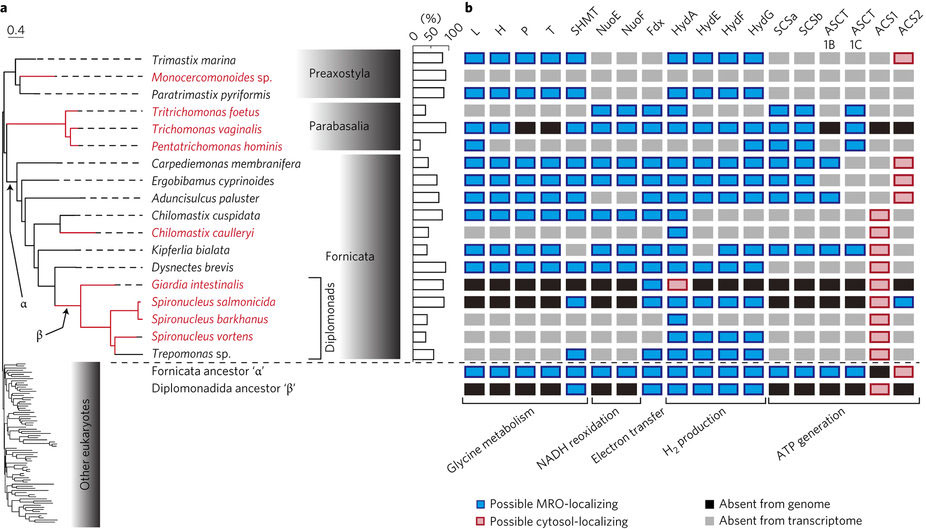Research Abstract
TrichomonasのヒドロゲノソームとGiardiaのマイトソームの起源の手がかりとなる細胞小器官
Organelles that illuminate the origins of Trichomonas hydrogenosomes and Giardia mitosomes
2017年3月17日 Nature Ecology & Evolution 1 : 92 doi: 10.1038/s41559-017-0092

嫌気性の寄生性真核微生物の多くは、ミトコンドリア関連オルガネラ(MRO)として知られる高度に変化したミトコンドリアを有している。その中で最も研究が進んでいるのは、膣トリコモナス(Trichomonas vaginalis)およびSpironucleus salmonicidaのヒドロゲノソームで、これらは水素の産生を伴う基質レベルのリン酸化を介してATPを嫌気的に産生する。また、ランブル鞭毛虫(Giardia intestinalis)のマイトソームは機能的に退縮していて、あらゆるATP産生機能を欠いている。しかし、これらのMROが寄生生活に適応する中で経てきた代謝の特殊化を解明するには、これらに近縁な自由生活性生物のデータが必要である。今回我々は、メタモナス類という大きな真核生物群のMROに関する大規模なトランスクリプトーム比較解析を行い、Trichomonas、Giardia、Spironucleus、およびそれらに近縁な自由生活性メタモナス類のMROについて、代謝機能の系統特異的な獲得や喪失を調べた。解析の結果、Giardiaなどのディプロモナス類とそれに最も近縁なDysnectesのATP産生機構の複雑な進化史や、グリシン開裂系と生活様式との相関が明らかになった。今回のデータはさらに、水素を産生するがATP合成能は持たないという、まだ記載報告されていない生化学的クラスのMROの存在も示唆している。
Corresponding Author
Many anaerobic microbial parasites possess highly modified mitochondria known as mitochondrion-related organelles (MROs). The best-studied of these are the hydrogenosomes of Trichomonas vaginalis and Spironucleus salmonicida, which produce ATP anaerobically through substrate-level phosphorylation with concomitant hydrogen production; and the mitosomes of Giardia intestinalis, which are functionally reduced and lack any role in ATP production. However, to understand the metabolic specializations that these MROs underwent in adaptation to parasitism, data from their free-living relatives are needed. Here, we present a large-scale comparative transcriptomic study of MROs across a major eukaryotic group, Metamonada, examining lineage-specific gain and loss of metabolic functions in the MROs of Trichomonas, Giardia, Spironucleus and their free-living relatives. Our analyses uncover a complex history of ATP production machinery in diplomonads such as Giardia, and their closest relative, Dysnectes; and a correlation between the glycine cleavage machinery and lifestyles. Our data further suggest the existence of a previously undescribed biochemical class of MRO that generates hydrogen but is incapable of ATP synthesis.

